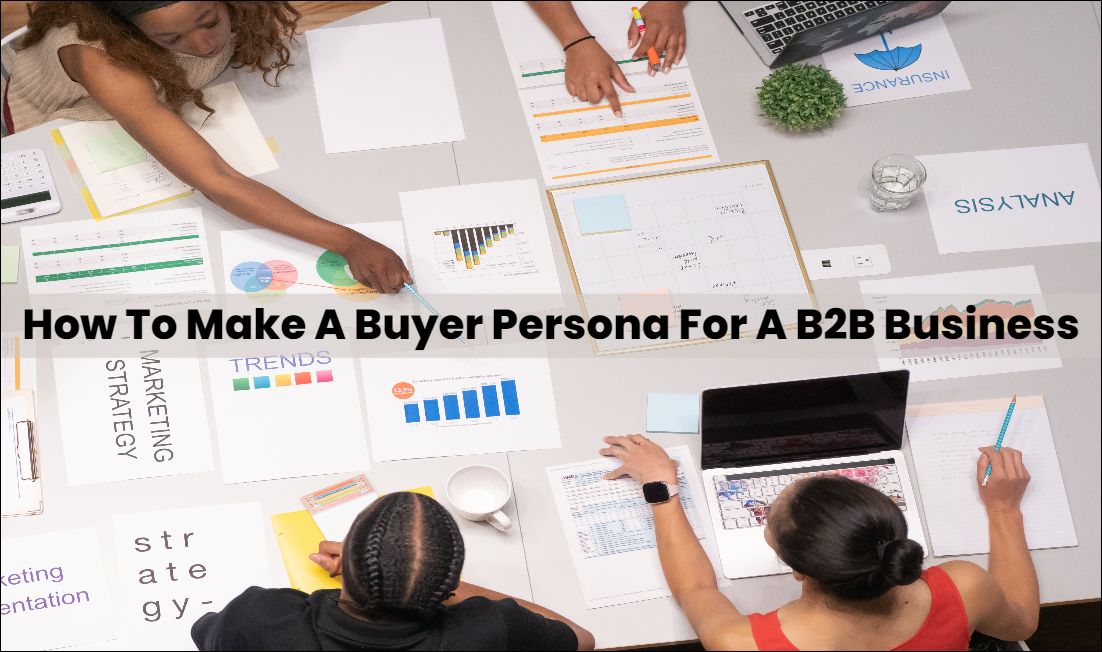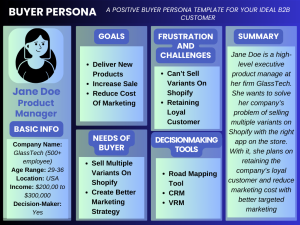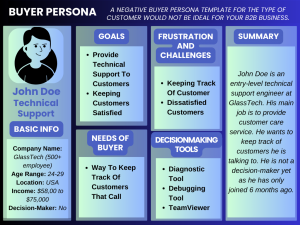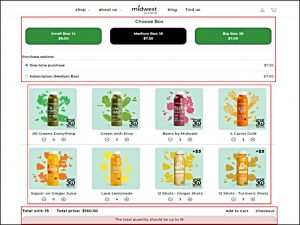
Understanding your customers’ needs is essential. In the B2B or B2C market, gaining a deeper understanding of your customers will help increase your sales and profit. The one framework that allows your business to understand your customers is through buyer personas.
Rock Content blog states that 82% of the companies created better quality value propositions with the help of buyer personas.
This article will explain creating a buyer persona for a B2B business. I will also include examples of what a buyer persona should look like for a B2B business. And finally, I will explain how you can use your buyer persona to target your customers better.
What Is A Buyer Persona?
So, before getting on the steps to making a buyer persona, we should first understand what a buyer persona is.
A buyer persona is not a strategy; rather it is a tool for marketing strategies. It is a fictional description of a potential buyer. It acts as a representation of your business’s target audience. While it might be fictional, it is backed by created with extensive research to back the data included in the fictional persona.
A buyer persona allows your business to understand better how your customers think. It is like thinking from a customer’s perspective. A B2C buyer persona deals with potential customers who might interact with your store. With that knowledge, targeting those customers with advertisements and marketing strategies is more manageable.
However, a B2B buyer persona is different. It is the same, but the persona tackles the decision-makers in your customer’s business. It helps to understand your customers better, especially for B2B stores with online stores like Shopify. It helps align what different departments of your business should be doing to help market your products and services.
Step-By-Step Guide To Make A Buyer Persona For A B2B Business
So, how to make a buyer persona for a B2B business? It can be difficult to know where to start. So here is a step-by-step guide on how to make a buyer persona from start to finish:
Step #1 Choose Your Ideal Customer
Since the buyer persona is based on a real-life customer, you need to find that ideal customer first on which to base the fictional persona. This is the most crucial step, setting up the buyer’s whole persona. Picking the ideal customer for your business requires extensive data on your current customer base and target audience.
Here are some things to consider when you are trying to figure out your ideal customers:
- The B2B industry focus you are part of
- Company size of target customer
- Geographic location
- Annual revenue
- Job title of the perfect customer
Understanding these specifics will help you create targeted buyer personas that truly connect with your ideal clients. You can choose multiple people for this stage and narrow down who you want to target.
Step #2 Create The Buyer Persona Interview Questions
So now that you have the ideal customer, it is time to get first-hand feedback from them. This is done through an interview where you ask them questions based on the product and service they received from you.
Here are some basic questions to ask in the buyer persona interview:
- Location: Where their company is based in/what market they are part of
- Age: An age range which they fall under
- Gender: What the customer identifies as
- Interests: Interests and hobbies related to your product and service
- Education: Level of education
- Job title: Where in the hierarchy they fall under
- Purchasing power: Purchasing power of this persona
- Decision-maker: A simple yes or no question whether they are a part of the final decision before buying a product or service
- Relationship status: Current relationship status
- Language: How many languages do they speak/communicate in the business
- Favorite websites: What websites they frequently visit to find products
- Buying motivations: What led them to want to buy your product and service
- Buying concerns: What might cause them hesitation in buying your products
In this part, the interview questions will differ depending on the persona you want to create. Some can target a broad audience, while others can be specific to an owner or stakeholder at your client’s business. Either way, the interview questions will help you gain knowledge when you are creating your B2B business’s buyer persona.
Step #3 Fill In Basic Demographic Information
Now is the time to create your business’s actual B2B buyer persona. The first set of information you should start with is the basic demographic information of the buyer.
Gather demographic data about your target audience, including job titles, company size, industry, geographic location, and other relevant characteristics defining your ideal customers.
Step #4 Outline the Frustrations And Challenges Of the Buyer
The next step in creation is discovering buyer’s frustrations and challenges when doing their business.
Put yourself in the shoes of your target audience. What struggles do they encounter in their day-to-day roles? Are there recurring challenges or obstacles that hinder their success? By understanding their problems, you can tailor your products or services to provide solutions that meet their needs and help them achieve their goals.
Using the answers from your interview, you can fill this section of the buyer persona to match the pain points that the buyer faces when they are doing business.
Step #5 Identifying the Needs Of Your Buyer
Once you have identified the customer’s wants, it is time to determine their goal.
Dig deep into what matters most to your target audience. What are their top priorities and goals? What outcomes are they hoping to achieve? Understand the features and functionalities they value most in a solution and consider other factors shaping their decision-making process.
By genuinely connecting with their needs and preferences, you can tailor your offerings to provide the best possible solution for them with your product and services.
Step #6 Find The Tools They Use To Make Decisions
We have covered their pain points and what they are looking for. It is now time to write down what tools they are using to find the solution they seek. This is important because the customers can come to your store in different stages of the B2B buyer’s journey.
Think about where your target audience turns for information and advice. Are they active on specific social media platforms, engaged in industry forums, or attending relevant events? Consider the publications they trust and the recommendations they value from peers.
Knowing their preferred channels and resources enables you to effectively reach and engage with them as they navigate their decision-making journey. So, ensure this section is filled out with what you learned through your interview.
Step #7 Summarizing All The Details
This is the step where you summarize all the details you have laid out in the buyer’s persona. The buyer’s persona can be so detailed that dissecting all the data can be confusing. This can seem redundant, but it is essential to streamline the data so everyone can understand it.
That is where the summary of all the details helps your business, especially in meetings where you discuss strategies with other departments. With a summary highlighting all the critical points of the persona, it can be easy to follow the buyer persona for others.
Step #8 Update Your Buyer Persona Regularly
The last step is just as important as the first. The industry never stays relatively the same, so your buyer persona should be regularly updated to match the industry and the changes in your ideal customers.
Regularly check with them to gather feedback and insights as market conditions and industry trends shift. By staying proactive and responsive to their changing preferences, you can ensure that your buyer persona remains up-to-date, accurate, and relevant, allowing you to continue meeting their needs effectively. With all these steps, you can have the perfect buyer personas for your B2B business.
B2B Buyer Persona Examples – Positive And Negative Personas
Following the steps can be difficult if you don’t clearly outline what a B2B buyer persona should look like. Noting everything down as outlined in the steps can be good enough. However, it is all about the presentation of the data so that it is easy for everyone in your business to understand.
So below, I will highlight the two most common B2B buyer persona examples: positive and negative buyer persona:
Positive B2B Buyer Persona Example
A positive B2B buyer persona example is easy enough to understand. It is the customer that you want to engage with your business. They should look something like this:

Negative B2B Buyer Persona Example
The negative B2B buyer persona example might seem a bit weird. It is the buyer persona that your business wants to avoid. It can happen because you might not have interviewed the correct ideal customer. But this negative buyer persona can yield greater insight into your audience base. It should look something like this:

Using Your B2B Buyer Persona With A Bulk Order App On Shopify
Remember, A B2B buyer persona is just the tool for your marketing strategy. It is not enough to create it; you will also need to use it. So, how do you benefit from a buyer persona?
Here is an example of an online store and how they implemented a buyer persona with a mix-and-match bulk order app on their Shopify store:

From this store page, we can see many options available for customers. First, it is choosing the number in the box and the purchase option. They are shown on top where subscription-based and one-time purchase customers can select which one they prefer. There are also options for customers to choose how many they want in the box. This allows customers to have the freedom to choose however much they want.
Next, we come to the selection of the products. The variant display showcases all the available options that customers can choose from. This reduces the need for multiple store pages to accommodate all variants. Instead, customers can choose all the options on one page.
At the bottom, the customers can see the price of their bundle box in real time. The dynamic pricing change lets customers decide more before putting the products in the cart. It removes the frustration of adding and removing products on the product page instead of the checkout page.
Lastly, the store added a limit depending on the box bundle amount. The total amount selected was 19, but only 18 were allowed. Therefore, the customer cannot add to the cart or go to the checkout page without adding the right amount. This allows the store to keep inventory in check and prevents customers from ordering too much.
An app like this covers all the bases for the different buyers a store might have. From the various buyer personas of the store, they can cater to all their customers with just one app. It helps segment all customers into one product page while keeping the shopping experience as streamlined as possible.
Bottom Line
Creating a B2B buyer persona is critical in understanding and connecting with your target audience. By researching, developing, and implementing buyer personas, you can tailor your marketing efforts to resonate with your ideal customers and drive business growth. With this step-by-step guide, you can learn how to make a buyer persona for a B2B business that you can continually expand on.
